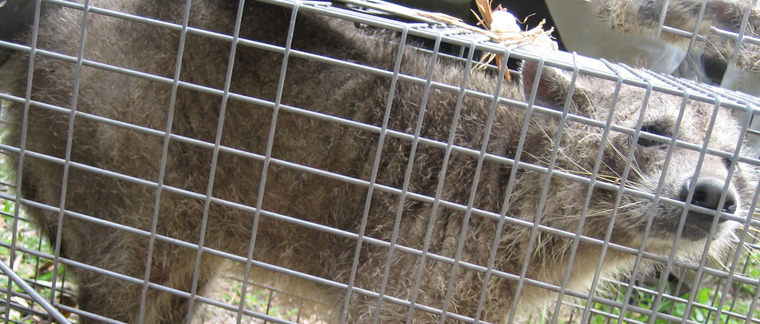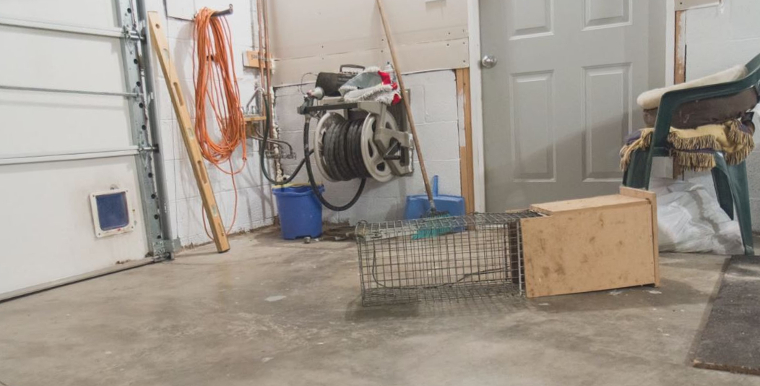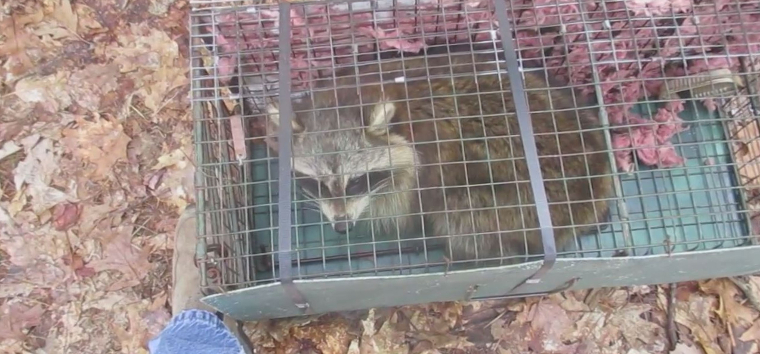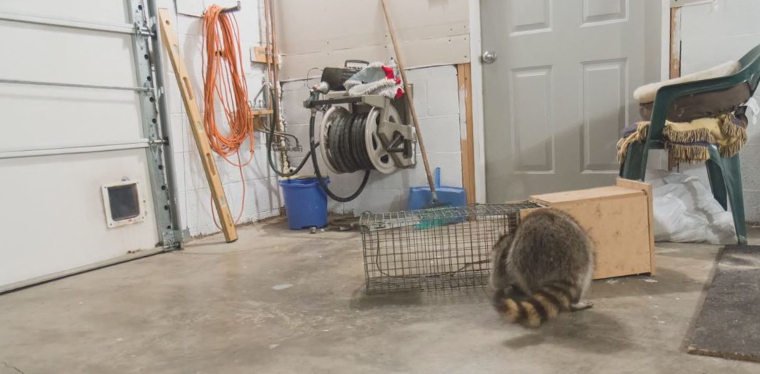-
info@aaanimalcontrol.com
Call us for help in your town
Humane Wildlife Education
Steps To Make A Raccoon Trap
Need raccoon removal in your hometown? We service over 500 USA locations! Click here to hire us in your town and check prices - updated for year 2020.
You may think that a raccoon is a rather cute animal, that does not mean that you want it around your home. Not only will raccoons attack you if you attempt to get close to them, but you also have the concern that many of these animals carry diseases that are quite dangerous to you. Scientists propose that about 20% of all raccoons carry rabies, which if you were to contract this disease could eventually lead to death if not treated right away. It is for this reason that you want to do all you can to keep a raccoon away from your home.

The problem is that these are not the easiest animals to be able to deter. Once they have found a food source or they have figured out a way to use your home as their own shelter then they can be a real handful to try to get rid of. This is why you have to be smart about how to resolve your issue, and that most likely is to capture the raccoon and take it to another location.
You may think this is a great idea, but you don’t want to spend a lot of money on a trap to be able to do this. Fortunately, there is a way that you can resolve your rat problem without really spending any money at all, so here is how to make a raccoon trap.
We can answer: How smart are raccoons?
Where you want to begin is by getting a simple trashcan or barrel. The taller the can the better off you are. The important thing about your barrel or trashcan is that it has smooth sides. The last thing you want is to offer the raccoon a means to get out by the can having rough edges that it can grip.
What you want to do next is to place the can or barrel at the end of the table. The lip of the can should be lower than the table itself. If you are looking to terminate the raccoon, then what you want to do is to fill the trashcan about halfway full of water. Otherwise, if trapping the animal is your goal then all you need to do is to place a small amount of water so that it would not completely cover the raccoon.
Find out all you need to know about raccoon feces.
Next, take some peanuts or some other kind of food that the raccoon would like and set a trail that heads to the trashcan or barrel. Pour a liberal amount of this snack inside the garbage can that you are done.
What will happen now is that the raccoon will follow the treats to the garbage can or barrel. It will see those snacks and find it too enticing to ignore. The raccoon then falls in and either drowns or is simply not able to get out. Just so you are aware, make sure that you do place at least some water inside the garbage can. This will ensure that it stays heavy and that the raccoon cannot tip it over.
Can You Trap a Cage-Shy Raccoon?
Need raccoon removal in your hometown? We service over 500 USA locations! Click here to hire us in your town and check prices- updated for year 2020.
Yes, you can trap a cage or trap-shy raccoon, but you're going to need to change your approach and be smart about it.
If the raccoon you're trying to catch doesn't go anywhere near your trap, there's a good chance you might have put the trap in entirely the wrong place. Raccoons won't stray from their 'known paths' unless they have a reason to, although they are known for travelling vast distances. If you put a trap right at the end of your garden, however, and the raccoon never goes to that part of the garden, you're never going to trap it.

There are lots of ways in which you can find the spots on your property that are home to the most nocturnal raccoon activity — look for feces in latrines (these will be close, but not too close to, raccoon nests and feeding spots), urine patches or staining for fur-grease, or perhaps even patches of fur from small fights between friends, siblings, or rivals. You may notice damage or paw prints too — they will usually lead the way.
When you find these areas of raccoon activity, that's where the traps should go. That is where they are likely to have the best effects.
If moving the traps doesn't work, you could look at changing your bait. It must be remember, however, that raccoons will eat pretty much everything and anything, including garbage from garbage cans. It is more likely trap placement than bait that is stopping the raccoon from getting too close, although we can personally recommend marshmallows if you've tried with everything else to no avail.
If moving the trap and changing the bait doesn't work, there are still other tricks you can try. If you are dealing with a raccoon that has already been trapped and then released back into the wild, perhaps multiple times, you can't expect the raccoon to continue to walk blindly into traps. They are really smart creatures — it will only take one or two trapping events for the animal to realise the big shiny thing isn't good for it.
If this is the case for your raccoon (although, it's not like the animal could actually tell you), you will need to be patient with the animal and understand that it has already been through a pretty traumatic trapping time. You will need to lure the animal into a false sense of security, as it were; encouraging it to come closer and closer to the trap by … well, not actually setting it.
Although not a foolproof plan, putting traps down without bait and without setting them for one or two nights can have some positive results. The animal can get more comfortable with the trap being there, without food. It'll be curious about it, perhaps, but maybe not. But the trap won't go off — that's the point. Nothing happens when and if the raccoon (or anything else) gets too close. You could even try to camouflage the trap. (We personally recommend this for tough-trappees)
After a few nights, the trap should have bait placed inside it, but you still shouldn't set the trap to actually go off. Again, the raccoon should become comfortable with the trap, pottering in and out as it pleases, taking the food and still being able to run off.
After a few nights of this, it's time to set the trap. The animal has become more comfortable with it (hopefully), and it should work.
If you still can't catch the damn animal, you might want to take a closer look. Could it be stuck somewhere? Maybe it just keeps giving you the slip? Wildlife rehabilitators are there when all of your other efforts have failed, and they're usually not half as expensive as you might think.
Raccoon Trapping Equipment
Need raccoon removal in your hometown? We service over 500 USA locations! Click here to hire us in your town and check prices- updated for year 2020.
If you plan to remove a rogue raccoon from your property without the assistance of wildlife rehabilitators, you are going to need a pretty extensive list of equipment. We have compiled a list of things that you DEFINITELY NEED, and then a few things that you MIGHT need.

Necessities:
Eye protection, such as safety goggles
Breathing/face mask to prevent inhalation of disease spores
Thick rubber gloves
Full body coveralls
Disposable boot/shoe covers
Garbage bags
Fire pit or similar fire site
Cleaning products — bleach, anti-fungal, antibacterial, antiseptic
Cleaning tools - brushes, sponges, etc.
Spray bottles
Traps — kill traps, live cage traps, DIY traps
Bait
You must be prepared to sacrifice all items that you use during the raccoon trapping operation. There are disease spores present in all biological matter left and touched by the animal, and without effective disposal or cleanup, these disease spores could then be left to infect your entire family, including your pets, and could even have much greater and farther repercussions than that.
You Might Need:
Cutting equipment (if raccoons are stuck in wall cavities and other tight spots)
Wall repairing equipment
Snare pole trap
Humane method of destruction (check laws in your state)
Attic insulation replacement
Electrician for damaged cables/wires
Other contractors for damaged plumbing/building exterior/etc.
If All Fails:
Phone number for a really reliable wild animal control officer who deals with raccoons in your area.
Once you add the cost of all of these things up, you will soon understand why it is usually a cheaper and faster option to call in wildlife rehabilitators. A live cage trap can cost anywhere from $50 to $100, depending on the brand, type, model, and more. If you have more than one raccoon, or can't pinpoint the raccoon activity to one specific area, you may even find that you need more than one trap, bumping the cost up.
Now add on to that the cost of all of the products and equipment you will need for repairing and clearing up after the animal, as well as materials necessary to seal any entry points the animal found, and you have a very costly job. If you were to call up and get yourself a quote from one of the local wildlife rehabilitators in your area, you might just be surprised by how much cheaper the experts actually end up being.
The Legalities of Trapping Pest Raccoons
Need raccoon removal in your hometown? We service over 500 USA locations! Click here to hire us in your town and check prices- updated for year 2020.
The subject of raccoons as pests comes up frequently, with opinions definitely divided. On one side, raccoons are known to be one of the biggest rabies vectors across the country, and rabies is a disease that NO ONE wants to be a big problem. On the other side of the coin, however, perfectly healthy raccoons may need to be destroyed because of their dangerous pest status.

The legalities of trapping pest raccoons change from state to state. Before any action is taken, we would highly recommend that you seek advice from a professional. You will be able to find further information on raccoon trapping laws in your state on the internet, but always make sure that you're looking at a reliable government resource or that the website has the stated its sources so that you can check the information for yourself.
Local city or county services can offer some information, and most wildlife rehabilitators are happy to provide you with details over the phone, without the need for an actual appointment. This is definitely the case if it means saving the life of an animal or making sure you — the property owner — doesn't end up going to jail.
The truth about trapping raccoons and, more specifically, the legalities surrounding the subject is this: you are responsible for checking the laws in your area BEFORE taking any raccoon trapping action. You will be held responsible for anything that goes wrong because of your negligence, either accidentally and naively or otherwise.
It is within YOUR best interests to make sure you know the rules before you start playing around with the lives of wild animals that don't need to be destroyed.
Where Should I Release a Raccoon I Trapped?
Need raccoon removal in your hometown? We service over 500 USA locations! Click here to hire us in your town and check prices- updated for year 2020.
Raccoons like to live in areas that are close to water, but there needs to be plenty of trees around too. They don't like to live in open meadows or places like that, because they are large and open spaces and, therefore, offer the animal nothing in the way of protection. Owls and other birds of prey from the sky can easily see them, and for a mother with kits, that means moving the babies from one place to another can be a life or death process.

Life on the ground doesn't really get any better for a raccoon on the ground either, in these large and open spaces with no trees. There are plenty of predators hiding in the shadows, and they'll be more than tempted to come out for a tasty snack. Again, this is even more so the case if a raccoon has kits.
Raccoons should be released in areas that they would naturally head for, so lakes, rivers, streams, and other watery spots are smart. Look up too — if you can see the tops of plenty of trees, those trees will offer your new furry friend (or foe) plenty of protection.
Raccoons are nocturnal creatures, but the release time of your raccoon isn't actually that important. In reality, the chances of your raccoon family lasting for long in the new home you've found for them are slim. Many trapped-and-released animals actually don't live for long once they're reintroduced. Those that can survive are driven far enough away from the capture point in the first place, or they just make it right back home again, sometimes, before you even do.
As a final note, it must be remembered that there are very strict regulations regarding the release of raccoons back into the wild, particularly in states where the animal is known for being a high-risk rabies vector. If that is the case for your state, you would need to get permission from the landowner before you could release the creature, and you may even find yourself in need of a permit for driving it to the release spot. In these high-risk places, trapping, killing, and even moving (transporting) the animal is subject to permits or licenses.
For more information, you may want to click on one of these guides that I wrote:
How much does raccoon removal cost? - get the lowdown on prices.
How to get rid of raccoons - my main raccoon removal info guide.
Example raccoon trapping photographs - get do-it-yourself ideas.
Raccoon job blog - learn from great examples of raccoon jobs I've done.


















